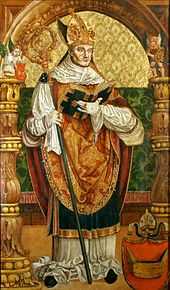Piotr Tomicki

Piotr Tomicki (1464 - 19 October 1535) was a Roman Catholic Bishop of Przemyśl, of Poznań and of Kraków and Vice-Chancellor of the Crown and Royal Secretary.[1] Celebrated as one of the most important representatives of the Polish Renaissance, he studied in Italy,[1] was part of the court of Jan Lubrański and had contacts with many of the enlightened minds of Europe, including Erasmus of Rotterdam.[2]
Tomicki's main merit was to be a patron of artists. Throughout his life he showed great interest in arts, specially sculptures. His collection of sculptures between 1520-30 only rivalled that of the king's.[3] Under his guidance Andrzej Górski wrote Acta Tomiciana, a collection of documents from the time of Tomicki's service as chancelor, and the Kraków Academy created the department of Roman Law and introduced the teaching of Greek and Hebrew.
Life
Tomicki was born in 1464 near Poznan as the son of Mikołaj of Tomice, a Chorąży from Poznań and Anny of Szamotuły. After his father's death in 1478, he went to the court of his uncle, Andrzej Szamotuły, then governor of Poznań. It is known that he studied at the cathedral school in Gniezno, then about 1486 he studied in Leipzig and shortly after that at the Academy of Kraków, where he earned his bachelor's degree in 1490, and in 1493 his magistrature in philosophy. The same year he began studying law in Bologna, finishing his doctorate in 1500.[1]
Immediately after graduation he began working in the Roman Curia, becoming chancellor of Cardinal Fryderyk Jagiellończyk, who gave him a number of ecclesiastical benefices, including the archdeaconry of Kraków, although he was not a clergyman. After the death of Cardinal Fryderyk, he went to the court of the bishop of Poznań, Jan Lubrański, where he lived between 1503-1506. Then he went to the office of the crown of King Sigismund I the Old, in whose service as secretary he repeatedly envoied to Hungary, Wallachia, and Pomerania.
In 1511 he was ordained priest, and in 1514 he was consecrated Bishop of Przemyśl. A year later he became Vice-Chancelor of the Crown, office which he hed until his death. In 1515, together with Chancellor Krzysztof Szydłowiecki he became the main benefactor of a settlement with the Habsburgs.[1] After the death of Jan Lubrański in 1520, he became bishop in Poznań, renouncing the position as bishop of Przemyśl. He resided in Wielkopolska for a while, devoting his time to politics and working for the royal court. In 1525, he became bishop of Kraków while he was still bishop of Poznań, Apostolic Nuncio and collector of papal tributes.[1] In 1526 he abdicated his position as bishop in Poznań, when he conducted an amicable agreement between the king and Albert Hohenzollern. Tomicki served as Bishop of Kraków and Vice-Chancelor of the Crown from 1525, which was inconsistent with the then Polish law. That was called Incompatibilitas. It was one of the main reasons for opposition near Szydłowiec during the Execution movement.
Piotr Tomicki died in Kraków on 19 October 1535. He was buried in a chapel in the Royal Wawel Cathedral founded by himself.
He is one of the characters on the famous painting by Jan Matejko, Prussian Homage.
References
- ↑ 1.0 1.1 1.2 1.3 1.4 Glomski, Jacqueline. Patronage and Humanist Literature in the Age of the Jagiellons: Court and Career in the Writings of Rudolf Agricola Junior, Valentin Eck, and Leonard Cox. University of Toronto Press. p. 126. ISBN 0-8020-9300-0.
- ↑ Segel, Harold B. (1989). Renaissance culture in Poland: the rise of humanism, 1470-1543. Cornell University Press. p. 13. ISBN 0-8014-2286-8.
- ↑ Schulz, Anne Markham (1998). Giammaria Mosca Called Padovano: A Renaissance Sculptor in Italy and Poland. Pennsylvania State University Press. p. 168. ISBN 0-271-01674-4.
- Attribution
- This article is based on the corresponding article of the Polish Wikipedia. A list of contributors can be found there at the History section.
Further reading
- Fr. Piotr Nitecki, The Bishops of the Church in Poland in the years 965-1999. Biographical Dictionary, ed. II Amendments and additions, Warsaw (2000), p. 451-452. ISBN 83-211-1311-7.
External links
- Acta Tomiciana at Wielkopolska Biblioteka Cyfrowa